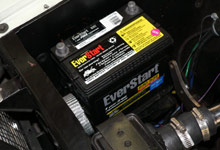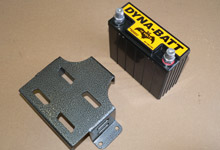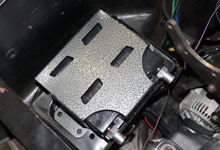|

By FordMuscle staff.
Battery Basics
The lead-acid automotive battery hasn't changed much since
Gaston Plante invented it in the late 18th century. A lead-acid
battery creates electrical energy through a chemical reaction.
Inside the battery are cells consisting of a lead plate and
a lead dioxide plate both submerged in a sulfuric acid and
water solution. The acid reacts with the lead plate (anode)
to form lead sulfate and release two electrons. The electrons
react with the lead dioxide plate (cathode) to form water
and more lead sulfate. Each cell produces a characteristic
2.1 volts, and automotive batteries typically have six cells
to produce 12.6 volts at full charge. One of the major reasons
that automotive battery design hasn't changed much over the
years is that this sort of electrochemical battery is fully
rechargeable. When excess voltage is applied to the cathode
(the function of the vehicles alternator) the reaction reverses
and the battery recharges. This can be done over and over
again, making automotive batteries a very long lasting and
reliable power source.
The original battery design is considered a "flooded"
design because the lead plates sit in liquid sulfuric acid
and water. This liquid electrolyte solution adds volume and
weight and is subject to boiling, releasing potentially dangerous
sulfur acid vapor. A more recent design is the sealed lead-acid
(SLA) battery (also termed valve regulated lead-acid VRLA.)
These batteries immobilize the electrolyte either in a gel
form, or by absorbing it in glass fiber plates that separate
the cells of the battery.
Sealed Lead Acid Batteries
The advantages of an SLA battery present itself in the form
of a smaller overall size and better safety since there is
no liquid to spill or boil off. In fact, the battery terminals
will never corrode either since there is none of the white
sulfuric acid precipitate buildup outside the battery. The
12V Dyna-Batt, sold by Performance Distributors is a great
example of how an automotive enthusiast can benefit from SLA
batteries. The major gains come in weight savings. The Dyna-Batt
weighs under 14 lb., compared to 30-45 lb. for conventional
flooded batteries. The size also offers space savings, and
can often be the solution in a cramped engine compartment
when installing a larger engine or tubing for super and turbo
chargers. Along with size, the ability to mount the battery
in any position or angle also increases location flexibility.

 On early Ford's the factory battery location was usually
at the right front corner of the engine bay. This arguably
counterbalanced some of the drivers weight. However on
late-model Mustangs and other Fords the battery is on
the same side as the driver making for some very poor
weight distribution.
On early Ford's the factory battery location was usually
at the right front corner of the engine bay. This arguably
counterbalanced some of the drivers weight. However on
late-model Mustangs and other Fords the battery is on
the same side as the driver making for some very poor
weight distribution. |

 Just replacing the stock battery with a sealed lead-acid
(SLA) type like the Dyna-Batt will shed weight off the
front. Performance Distributors offers a nice bracket
which can be used in placed of the stock battery tray.
This battery is about the smallest SLA you'd want to run
to power a V8 street car as it has a minimal 280 cold
cranking amps.
Just replacing the stock battery with a sealed lead-acid
(SLA) type like the Dyna-Batt will shed weight off the
front. Performance Distributors offers a nice bracket
which can be used in placed of the stock battery tray.
This battery is about the smallest SLA you'd want to run
to power a V8 street car as it has a minimal 280 cold
cranking amps. |

 Here we see how the Dyna-Batt fits into the stock early
Mustang location on the passenger side fender. The stock
tray has been removed and this has freed up sufficient
space for the Vortech supercharger - not to mention offsetting
the additional weight of the blower headunit.
Here we see how the Dyna-Batt fits into the stock early
Mustang location on the passenger side fender. The stock
tray has been removed and this has freed up sufficient
space for the Vortech supercharger - not to mention offsetting
the additional weight of the blower headunit. |

 Unlike conventional flooded lead-acid batteries, SLA batteries
can be mounted in any position. This offers up a variety
of other mounting positions and locations as seen here.
The lifespan of SLA batteries are however affected by
heat. This location will stay cool due to the air flow
past the radiator support, but we'd recommend placing
it in the trunk or using a head shield covering.
Unlike conventional flooded lead-acid batteries, SLA batteries
can be mounted in any position. This offers up a variety
of other mounting positions and locations as seen here.
The lifespan of SLA batteries are however affected by
heat. This location will stay cool due to the air flow
past the radiator support, but we'd recommend placing
it in the trunk or using a head shield covering. |
To play fair we should compare cold cranking amps (CCA) and
reserve capacity (RC), as this is determined by the plate
size which correlates to the size, and weight, of the battery.
The battery council defines the CCA rating is the number of
amps a new, fully charged battery can deliver at 0° Fahrenheit
for 30 seconds, while maintaining a voltage of at least 7.2
volts, for a 12 volt battery. The higher the CCA rating, the
greater the starting power of the battery. Reserve Capacity
defines the battery's ability to power a vehicle without an
alternator. The rating is the number of minutes a battery
at 80 degrees F can be discharged at a load of 25 amps and
maintain a voltage of 10.5 volts for a 12 volt battery. The
higher the reserve rating, the longer your vehicle can operate
should your alternator or fan belt fail. According to Performance
Distributors, the Dyna-Batt isn't rated for CCA. The smallest
battery we could find off the shelf at WalMart (pictured in
the side bar) measured 8"H x 7"W x 5"D and
produced 740 cold cranking amps. We've run both batteries
in our Mustang and they both perform equally in terms of starting.
Are we comparing apples to oranges? Some say comparing cold
cranking amps of SLA and flooded batteries is akin to comparing
Mac and PC processor speeds. While the rated numbers may be
the same, the efficiencies and better design of the Mac, or
in this case an SLA battery, results in much better performance
than the conventional design.
Clearly if the SLA batteries were without any downsides you'd
see their widespread use in production vehicles. After all,
with today's fuel economy concerns an auto maker would kill
for shaving 25-30 lb. from their cars. There are tradeoffs
with SLA batteries, and they come in the form of temperature
tolerance. SLA battery performance and life span deteriorates
dramatically with heat. An SLA battery when maintained around
75 deg F. can last 8-10 years so long as it receives frequent
charging. However at conditions over 100 degrees the battery
life will degrade to under 2 years. Since underhood temps
are routinely very high in a modified vehicle we recommend
installing the SLA battery in your trunk. We've detailed how
to achieve this on the next page.
|